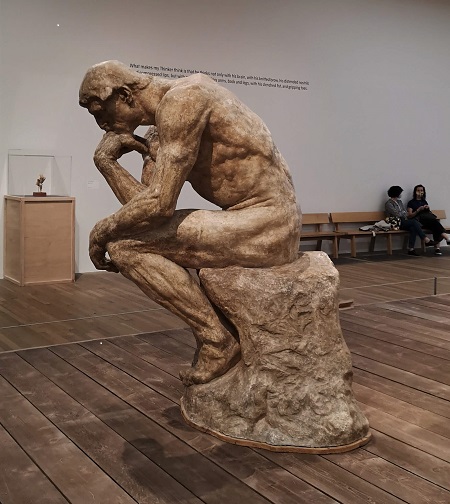The Thinker
I went to Tate Modern to see ‘The Making of Rodin’ exhibition. This was the first time I had been to a Gallery for some time, because of Covid restrictions. It was so good to see art again! Rodin’s plaster models in the exhibition show him experimenting with how to portray movement and form. He even explores how a man can be thinking with every muscle in his body.
‘The Thinker’ by Rodin illustrates the concept that bodies express our thoughts and feelings, that our mind and body work together as one unit. This concept underpins F M Alexander’s technique that we still teach today. Many people just associate the Alexander Technique with issues such as reducing back pain, which it has been proven to do. But AT work goes far deeper than people realise. For instance, when we react to stress, we often tighten our necks and backs, thereby contributing to painful problems there. We can learn how to avoid doing that….

Rodin’s ‘The Thinker’ at Tate Modern 2021
I was interested to see a great quote from Rodin on the wall. This reveals how Rodin made the Thinker think with his whole body:
‘What makes my Thinker think is that he thinks not only with his brain, with his knitted brow, his distended nostrils and compressed lips, but with every muscle of his arms, back and legs, with his clenched fist, and gripping toes‘. Rodin.
Alexander would have appreciated this statement as he believed we tend to ‘translate everything, whether physical, mental or spiritual, into muscular tension’ (Aphorisms). However Alexander realised this tendency can be modified by our conscious control. We can re-educate ourselves to respond differently.
Psychophysical Re-education
Alexander used the term ‘Psycho-physical‘ to express this mind-body unity:
‘The term is used…. to indicate the impossibility of separating “physical” and “mental” operations in … the working of the human organism’ . Constructive Conscious Control of the Individual 1923.
Alexander said he was forced to use the words ‘psycho’ and ‘physical’ because there is no other word that expresses the amalgamation of both concepts.
If Rodin’s Thinker was having Alexander lessons his teacher could explore how much pain he experiences in those scrunched up feet, neck, shoulders, wrist and back. How often does he assume that position? Is it a habit, or a one-off expression of internal turmoil? Can he re-educate himself, let go of his habit and learn to change the way he reacts to situations? If so, he can learn how to continue his thinking but without reacting in that way and creating more pain.
Psycho?
Unfortunately Alfred Hitchcock’s film ‘Psycho’ has greatly contributed to ‘psycho’ being associated with mental instability and psychosis. This can create a misunderstanding when AT teachers use the word psychophysical! But the AT is not to do with mental illness.
Alexander described his work in a rather heavy-handed Victorian style. Unfortunately, this also includes some passages that are considered offensive and racist today. Thankfully, at the end of his most popular book, ‘The Use of the Self‘, Alexander states he deplores prejudice, ‘racial or otherwise’. Teachers are searching for a new vocabulary to express Alexander’s ideas and his books are gradually being edited to make them easier to read and more acceptable for all audiences. The essence of Alexander’s discoveries is still valuable today, so it is well worth reading his books, with an understanding that present day teachers do not hold his Victorian views of the world.
All Aspects of our Being
An important part of Alexander lessons is when pupils begin to understand this concept of psychophysical unity, of how our minds and bodies work together. When we accept and embrace this fact, changes can take place. This can be very healing, as can be seen in this testimonial: